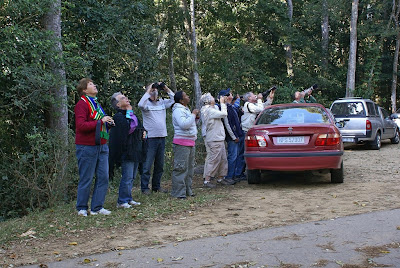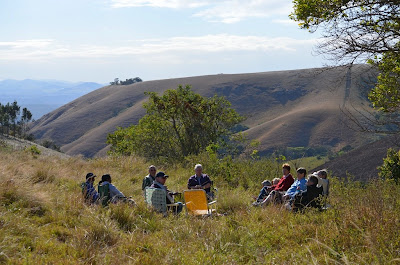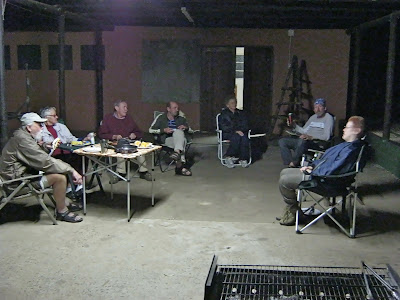 |
| Sunrise at Amatikulu (Photo Stan Culley) |
Attendees: Liz Blomeyer, Doug & Angie Butcher, Stan & Val Culley, Mike Fagan, Stanley & Asothie Gengan, Margaret Jones, Sandy Olver, Herbie Osborne, Hazel Parry, Andy Ruffle, Irma Smook, Bob & Hazel van Rooyen, Ron & Elaine Whitham, Barrie Willis & Sue Hansbury. (20 attendees)
Monday 16th July 2012
Having settled in to our accomodation, the group met at the tented camp for an afternoon walk down to the lagoon. An over wintering Osprey was seen by some, as was a Klaas' Cuckoo. White-breasted Cormorant were in abundance. A sculking Lesser Swamp-Warbler, calling amongst the reeds, made a nice addition to the Reserve List - strangely it's not on the list we have. As darkness fell, Swamp Nightjar could be heard calling in the close vicinity of the camp site.
Later, we all gathered at the Safari Tents for an evening of frivolity as only Trogons can do.
Tuesday 17th July 2012
Daybreak was hailed with the calls of no less than three Fiery-necked Nightjars and Robins a plenty around the camp site.
This morning we headed up to Ongoye Forest in search of the elusive Green Barbet. I'm pleased to say that this time they didn't disappoint, with atleast four birds being seen.
 |
| Not Naomi Campbell up a tree- something much better! Green Barbet (Photo Andy Ruffle) |
 |
| Green Barbet at Ongoye (Photo Hazel van Rooyen) |
 |
| Breakfast in the bundu at Ongoye (Photo Hazel van Rooyen) |
With the Green Barbet ticked, photographed and admired, and our caffeine requirements satisfied, we set course for St. Kitt's Wetlands, some thirty minutes away. Here, we hoped to find Lesser Jacana and Lesser Moorhen.....Hmmmmmmm.
 |
| White-breasted Cormorant breeding colony, St. Kitt's. (Photo Hazel van Rooyen) |
 |
| Scouring one of the St. Kitts' dams (Photo Andy Ruffle) |
Back at Amatikulu, our afternoon walk started from the camp site this time. With the wind still being rather strong, we didn't see a huge variety of birds, but the walk certainly built up our appetites.
 |
| The 'poor relatives' enjoy their soup kitchen before joining the larney bunch in the Safari Tents. (Photo Elaine Whitham) |
Wednesday 18th July 2012
Umlalazi Nature Reserve was the destination for our last full day. We were joined by local resident Fred Mittermeyer, who kindly took us in search of the Mangrove Kingfisher. With only 5-6 birds estimated to over winter in this reserve**, it was going to be like looking for a needle in a haystack.
 |
| Beautiful shot of Palm-nut Vulture at Umlalazi NR (Photo Hazel van Rooyen) |
 |
| ''I'm sure the Mangrove Kingfisher is here somewhere'' (Photo Andy Ruffle) |
 |
| Herbie watches as an African Finfoot [circled in red] swims to a far bank for cover (Photo Andy Ruffle) |
 |
| Mangrove Kingfisher, Umlalazi NR (Photo Hazel van Rooyen) |
Exhausted, we returned back to Amatikulu to spend our last evening together, before departing in the morning.
After a few tipples, the general concensus was that 3 nights is not long enough for our trips away , so we may just add another night for the next one.
Birds recorded: Sombre Greenbul, Yellow-breasted Apalis, Yellow-bellied Greenbul, Goliath Heron, White-breasted Cormorant, Reed Cormorant, Egyptian Goose, African Fish-Eagle, Tawny-flanked Prinia, African Pied Wagtail, African Firefinch, Dark-capped Bulbul, Cape White-eye, Hadeda Ibis, Black-headed Heron, African Jacana, Black-shouldered Kite, Black-collared Barbet, Thick-billed Weaver, Red-eyed Dove, African Dusky Flycatcher, Cattle Egret, Pied Kingfisher, Osprey, Yellow-fronted Canary, Yellow-billed Duck, Blacksmith Lapwing, Grey Heron, Spur-winged Goose, Green-backed Camaroptera, White-eared Barbet, Lesser Swamp-Warbler, African Olive-Pigeon, Klaas's Cuckoo, Red-capped Robin-Chat, Swamp Nightjar, Fiery-necked Nightjar, Pied Crow, Common Myna, Common Fiscal, Grey Crowned Crane, Hamerkop, Green Barbet, Ashy Flycatcher, African Stonechat, Common Moorhen, Little Grebe, Red-knobbed Coot, White-faced Whistling Duck, White-backed Duck, Long-crested Eagle, African Palm-Swift, Brown-throated Martin, Little Swift, African Darter, Black Saw-wing, African Swamphen, Malachite Kingfisher, Cape Weaver, Lesser Striped Swallow, Spectacled Weaver, African Paradise-Flycatcher, African Pipit, Green-backed Heron, Fiscal Flycatcher, Collared Sunbird, Purple-crested Turaco, Trumpeter Hornbill, Lemon Dove, Black-backed Puffback, Yellow-rumped Tinkerbird, Terrestrial Brownbul, Olive Sunbird, Southern Boubou, Woolly-necked Stork, Giant Kingfisher, Palm-nut Vulture, Three-banded Plover, Crowned Hornbill, Common Greenshank, Black-chested Snake-Eagle, African Finfoot, Cape Starling, Lizard Buzzard, Burchell's Coucal, Cardinal Woodpecker, Mangrove Kingfisher, Natal Spurfowl, Bronze Mannikin, Red-backed Mannikin, Black Cuckooshrike, Speckled Mousebird, Little Egret, Golden-tailed Woodpecker, Cape Wagtail, Square-tailed Drongo, Water Thick-knee, African Goshawk, Fan-tailed Widowbird, Yellow-throated Longclaw, Rufous-winged Cisticola, Dark-backed Weaver, Black-throated Wattle-eye, Black-bellied Starling, Chinspot Batis, Fork-tailed Drongo, Kurrichane Thrush, Little Bee-eater, Hottentot Teal, Black Crake, Red-headed Quelea, Wire-tailed Swallow, Little Rush-Warbler, Cape Teal, Southern Pochard, Cape Shoveler, African Marsh-Harrier, African Sacred Ibis, Ruff, African Snipe. (120 species) Please let me know if there are any additions
**Reference- Roberts' Online
No comments:
Post a Comment